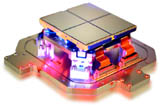Mar 4 2010
Teledyne Technologies Incorporated (NYSE:TDY) announced today that its subsidiary, Teledyne Scientific & Imaging, LLC (TS&I), has a key role in NASA’s Wide-field Infrared Survey Explorer (WISE), with two of Teledyne’s megapixel imaging sensors at the heart of the WISE infrared camera. The mission will be the most sensitive infrared survey ever made of the universe.
 Infrared sensor
Infrared sensor
Operating in a sun-synchronous low Earth orbit, WISE is designed to scan the entire sky in infrared light, picking up the glow of hundreds of millions of objects and producing millions of images. It is anticipated that objects never seen before will be discovered, including the coolest stars, the universe’s most luminous galaxies and some of the darkest near-Earth asteroids and comets. Its vast catalogs will help answer fundamental questions about the origins of planets, stars and galaxies, and provide a mountain of data for astronomers to mine for decades to come. The WISE catalog will guide the observations of the Hubble Space Telescope (HST), ground-based observatories, and the James Webb Space Telescope (JWST).
The WISE observatory is hundreds of times more sensitive than previous space missions due in part to its advanced detector technology. There are four megapixel infrared sensors in WISE and Teledyne provided two of them (each is 1024×1024 pixels). The Teledyne sensors detect light at bands centered at 3.4 and 4.6 microns; 5 to 7 times longer than the longest wavelengths that can be detected by the human eye. At these wavelengths, WISE will detect the thermal emission of cooler objects, such as brown dwarf stars, and will see the visible light from distant galaxies that has been stretched into infrared wavelengths by the expansion of the universe (known as “redshift”).
The Teledyne infrared detectors are made from an advanced detector technology pioneered by Teledyne called “substrate-removed HgCdTe.” The detector material is a crystal lattice that is specially grown from the elements mercury, cadmium and tellurium. This type of detector provides improved infrared sensitivity with the lowest noise, vital for detecting the faint signals from distant objects. Teledyne’s sensors with this advanced technology have already been critical to the success of several NASA missions. A megapixel sensor was installed in May 2009 in the HST Wide Field Camera 3 (WFC3) instrument, a combined visible-infrared sensor operated in the Moon Mineralogy Mapper that discovered water on the moon, and fifteen 4-megapixel sensors from Teledyne will be used in the JWST. Teledyne’s substrate-removed HgCdTe focal plane array is the baseline technology for several future space astronomy and Earth observation missions, and is now the standard for ground-based astronomy.
The most sensitive infrared surveys of the universe must be made from space to avoid the high level of infrared light produced by the Earth’s atmosphere and to avoid the absorption of infrared light by the atmosphere. In spite of the limitations of ground-based observations, the most thorough all-sky infrared survey to date has been the Two Micron All-Sky Survey (2MASS) that was conducted by the University of Massachusetts and the California Institute of Technology during 1997-2001. The 2MASS used telescopes located in Arizona and Chile with the largest infrared arrays that were available at the time; each infrared camera had three Teledyne sensors of 256×256 pixels, one-sixteenth the size of the WISE sensors. 2MASS produced a catalog of over 500 million objects that has guided infrared astronomy for the past decade.
JPL manages WISE for NASA’s Science Mission Directorate. The mission was competitively selected under NASA’s Explorers Program, which NASA’s Goddard Space Flight Center in Greenbelt, Md., manages. The Space Dynamics Laboratory in Logan, Utah, built the science instrument, and Ball Aerospace & Technologies Corp. of Boulder, Colo., built the spacecraft. Science operations and data processing take place at the Infrared Processing and Analysis Center at the California Institute of Technology in Pasadena. Caltech manages JPL for NASA.